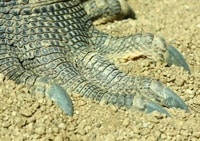New infrared methods provide fresh insights into fossilized reptiles.
Click image to enlarge It is now clear that lizard skin has changed very little in form over at least 50 million years. |
The organic compounds surviving in 50-million-year-old fossilized reptile skin have been visualized for the first time, using revolutionary new techniques, thanks to paleontologists and geochemists at the University of Manchester in northwest England.
The team of scientists, led by Roy Wogelius and Phil Manning, used state-of-the-art infrared technology to obtain the images showing soft tissue in the fossilized skin sample, which had been unearthed from the rocks of Utah’s Green River Formation. In addition, element-specific maps of organic material in the skin have been generated by members of the Manchester team, using X-rays at the Stanford synchrotron in the USA.
The Technique
The infrared light causes vibrations in the fossilized skin, and a map of where these vibrations occur can be obtained from a fossil by using a tiny crystal (like an old phonograph record stylus), which moves from point-to-point in a programmable grid across its surface.
At each point where the tiny crystal touches the fossil, an infrared beam that shines through the crystal reflects off the crystal base, but a small amount of the beam probes beyond the interface. If organic compounds are present, they absorb portions of the beam and change the reflected signal.
This allows the team to map large fossils that do not themselves transmit or reflect the beam in a noninvasive way, marking a revolutionary breakthrough for paleontologists.
The chemical information that has been revealed has also allowed scientists from Manchester’s School of Earth, Atmospheric and Environmental Sciences to gain a unique insight into how this exceptional state of preservation can arise.
When the original compounds in the skin begin to break down, they can form chemical bonds with trace metals, and under exceptional conditions, these trace metals act like a “bridge” to minerals in the sediment in which the fossil forms. This protects the skin material from being washed away or decomposing further.
Ancient and Modern
“The mapped distributions of organic compounds and trace metals in the 50 million year old skin look so much like maps we’ve made of modern lizard skin as a check on our work,” Wogelius said. “In fact, it is sometimes hard to tell which is the fossil and which is fresh skin.”
The results suggest that the trace metal constituents and patterns in ancient reptile skin, even after fossilization, are similar to those of modern reptiles, indicating that little change has occurred in their skin structure over many millions of years.
“The ability to carry out chemical analyses on rare and precious fossils like this, without the need to remove material and destroy it, is an important and long overdue advance in the field of paleontology,” said Nick Edwards, senior author of the study. “Hopefully this will provide future opportunities to unlock the information stored in other similarly preserved specimens.”
“Here physics, paleontology and chemistry have collided to yield incredible insight into the building blocks of fossilized soft tissue,” Manning said. “The long-term goal is now to discover the chemistry of ancient life.”
The paper, from The Proceedings of the Royal Society, is available here.



